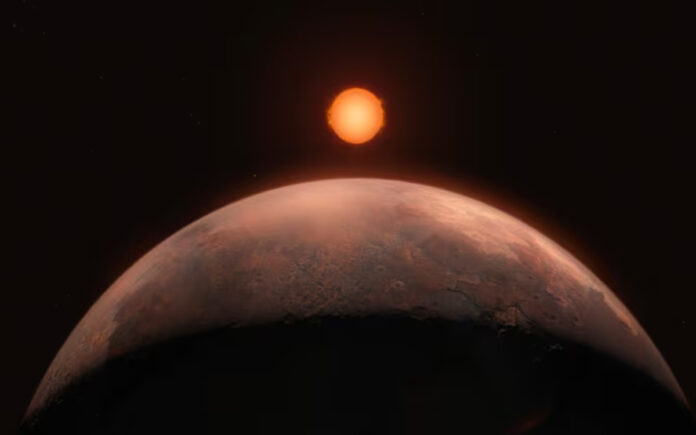Washington: Barnard’s star, a red dwarf and the smallest type of regular star, is significantly smaller and less luminous than our sun. Located approximately 6 light-years away, it holds the title of the closest single star—not in a binary system—to our solar system, making it a cosmic neighbor.
This proximity has ignited excitement among scientists eager to explore potentially habitable worlds, particularly with the recent discovery of the first confirmed planet orbiting Barnard’s star. This rocky planet, known as Barnard b, has a mass about 40% that of Earth.
While Barnard b orbits extremely close to its host star, resulting in a surface temperature deemed unsuitable for life, researchers have identified what they describe as “strong hints” of three additional planets surrounding Barnard’s star that could present better opportunities for habitability.
Barnard b boasts a predicted diameter of approximately three-quarters that of Earth, equating to around 6,000 miles (9,700 km). “It is one of the least massive planets ever found,” beyond our solar system, stated astronomer Jonay González Hernández of the Instituto de Astrofísica de Canarias in Tenerife, Spain, and the lead author of a study published this week in the journal Astronomy & Astrophysics. Among planets in our solar system, only Mars and Mercury are smaller.
With a surface temperature hovering around 275 degrees Fahrenheit (125 degrees Celsius), Barnard b completes an orbit around its star in just three Earth days, situated 20 times closer than Mercury is to our sun.
Also Read | Keir Starmer’s First Talks in Brussels Signal New Era for UK-EU Relations
Planets beyond our solar system are classified as exoplanets. Scientists in search of exoplanets capable of supporting life focus on those within the “habitable zone” surrounding a star, where conditions allow for liquid water to exist on the planetary surface—neither too hot nor too cold.
To detect Barnard b, researchers utilized an instrument called ESPRESSO on the European Southern Observatory’s Chile-based Very Large Telescope. The three other potential planets orbiting Barnard’s star are all presumed to be rocky and smaller than Earth, with masses ranging from 20% to 30% that of our planet. There is hope that at least one of these may reside within the habitable zone.
If confirmed, Barnard’s star would be the only known star hosting a multi-planet system comprised entirely of planets smaller than Earth.
Situated in the constellation Ophiuchus, Barnard’s star has a mass roughly 16% that of the sun, a diameter about 19% of it, and a much lower temperature. It is also estimated to be over twice as old as our sun. “Being so cold and small, it is quite faint, making its habitable zone much closer to the star than in the case of the sun,” remarked Instituto de Astrofísica de Canarias astronomer and study co-author Alejandro Suárez Mascareño. “It also is a very quiet star. While some red dwarfs have been found to flare very frequently, Barnard’s star doesn’t do it.”
Also Read | Biden Rejects Support for Israeli Strikes on Iranian Nuclear Facilities Amid Rising Tensions
The closer exoplanets are to us, the easier they are to study. Low-mass rocky planets orbiting red dwarfs, which are the most common type of star in our Milky Way galaxy, are simpler to detect than those around larger stars.
Only three stars in the Alpha Centauri system, approximately 4 light-years away, are closer to our solar system than Barnard’s star. A light-year represents the distance light travels in a year, amounting to about 5.9 trillion miles (9.5 trillion km). Two exoplanets have been discovered in the Alpha Centauri system, both orbiting the red dwarf Proxima Centauri—one with a mass comparable to Earth and the other about 25% of Earth’s mass.
While science fiction often portrays light-speed travel as commonplace, such capabilities remain far beyond human reach. However, initiatives like Breakthrough Starshot are investigating the feasibility of interstellar travel. Barnard’s star and Alpha Centauri could be prime targets for future exploration.
“While they are very close in astronomical terms, they are out of reach for any kind of human technology. However, if projects such as the Breakthrough Starshot are successful, it is likely that these will be some of the first targets,” Mascareño concluded.



